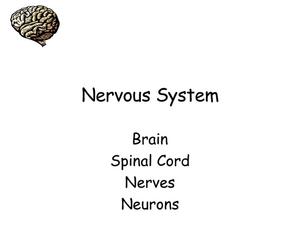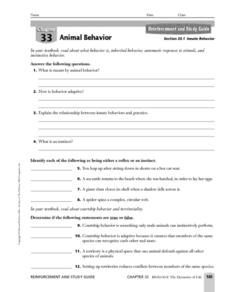Curated OER
Animal Behavior
Can you train a worm? Biology buffs will have a blast trying! Using planaria or earthworms, they introduce a certain stimulus repeatedly until the desired response happens more quickly. They also explore the response of their own eyes to...
Curated OER
Review of Animal Behavior
In this animal behavior worksheet, students complete a 50 multiple choice question review quiz on how animals respond to certain stimuli.
Curated OER
Animal Behavior
Students investigate stimulus-response behavior, learned behavior in animals and innate behavior in animals. In this animal behavior lesson plan, students answer questions about their reactions to a toy cap gun that is fired off in...
Curated OER
Types of Behavior: Animal Behavior Research
How does one determine what influences animal behavior; Is it nature or nurture? After a short reading explaining different types of conditioning and other learned behaviors, scholars examine six scenarios to determine whether the...
Curated OER
Animal Behavior
In this animal behavior instructional activity, learners will review various types of animal behavior including those that are instinctual and those that are learned. This instructional activity has 10 true or false and 8 matching...
Curated OER
Isopod Behavior, of the Rolly Polly Lab
Learners investigate the behavior of isopods. In this isopod lesson plan, students make observations of an isopod and sketch the pillbug. They study the orientation of the isopods in relation to moisture in a chamber they construct from...
Curated OER
Animal Behavior
In this animal behavior worksheet, students will read information about reflex behaviors and instinct behaviors. Then students will complete 1 short answer and 1 fill in the blank question.
Curated OER
Role of Cerci in Escape Responses of the Cockroach
High schoolers investigate the changes in escape behavior in Madagascar Hissing Cockroahes when their sensory apparatus is removed. They use puffs of air at differnt angles to simulate a predator's approach then collect and analyze data...
Curated OER
Learning in Cockroaches
Students make scientific observations. For this stimulus response lesson, students make observations and collect data to determine if cockroaches can learn. A secondary purpose of this lesson is to provide students with the opportunity...
Curated OER
Nervous System
After reading through this presentation about nerve impulses, students should be able to complete the sentences given with the correct terms and scientific vocabulary. The basics of the ion channel behavior are detailed along with a...
Curated OER
Innate Behavior
In this innate behavior activity, students compare inherited behavior and instinctive behavior. Students also look at behaviors resulting from internal and external cues. This activity has 4 short answer, 4 matching, 4 true or false, and...
Curated OER
Behavior Adaptations
For this behavior worksheet, students review different types of behavioral adaptations including migration, hibernation, and communication. This worksheet has 10 matching and 10 true or false questions.
Curated OER
Types of Behavior
In this behavior worksheet, high schoolers review the different types of behaviors including instinct, reflex, and learned behaviors. This worksheet has 10 terms in a crossword puzzle and 6 fill in the blank questions.
Curated OER
Learned Behavior
In this learned behavior learning exercise, students review different types of learned behavior including habituation and trial-and-error learning. This learning exercise has 7 short answer, 8 matching, and 10 fill in the blank questions.















